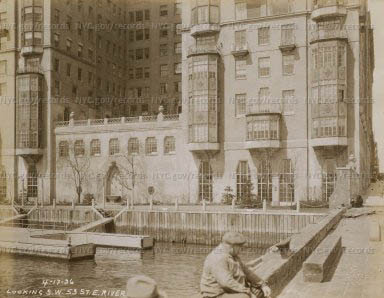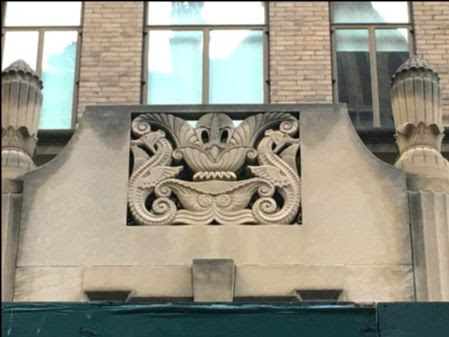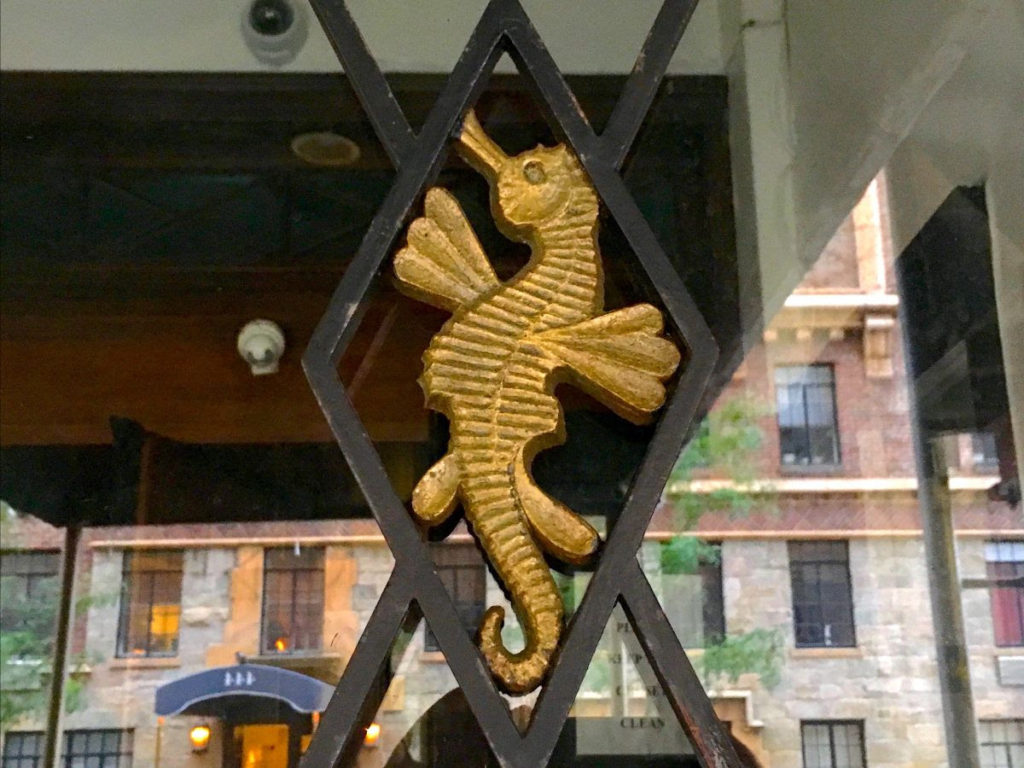Monday, January 4, 2020 – The East River waterfront before the FDR Drive



A BUILDING REFLECTING
THE GLORY OF THE 1930’S
Monday, January 4, 2021
Our 253rd Edition
RIVER HOUSE,
JUST A STEP AWAY FROM YOUR YACHT
TO MANHATTAN RESIDENCE
WITH MATERIAL FROM A EPHEMERAL NEW YORK
and
CITYSCAPES by CHRISTOPHER GRAY, NYTIMES (C) 2005

This luxury building had a private dock for yachts
River House, the majestic Art Deco apartment building at the end of East 52nd Street, offers lots of amenities.
Residents of this tony co-op built in 1931 on the site of a former cigar factory enter and exit through a cobblestone courtyard with a private driveway behind a wrought-iron fence.
Multi-room apartments have panoramic views of the East River, and the 26-story building features the River Club, a members-only club with a gym, pool, and dining room.

Too bad one of the original selling points River House dangled in front of its earliest prospective tenants is no longer there: a private dock on the East River where residents could park their yachts.
It’s hard to believe, but this really did exist. Even though the building opened during the Great Depression, that didn’t stop residents from using the dock to sail back and forth to their Long Island mansions, as one Daily News article from 1940 shows.

1936 NYC Municipal Archives Photo

Close-Up of River House Pier 1936
NYC Municipal Archives

The East River Drive sight looking north
NYC Municipal Archives

STREETSCAPES
When the Automobile Replaced the Yacht
By Christopher Gray
Feb. 27, 2005
Correction Appended
The streamlined, reinforced-concrete Franklin D. Roosevelt Drive remains one of New York’s most elegant public works. But when it was built in the 1930’s (as the East River Drive), it deprived many well-to-do East Side riparians of their river views and access. Among these, perhaps none sacrificed more than the members of the ultra-discreet River Club, built in 1931 between 52nd and 53rd Streets, which lost its romantic stone quay and yacht landing — and received in exchange a six-lane highway.
In the 1920’s, elite residential development washed the shores of the East River along Beekman Place, Sutton Place and East End Avenue. Part of this new shorefront dream was not just a view of the water but access to it. In 1925, the developer Joseph B. Thomas planned a Venetian-style gondola station for his medieval fantasy of an apartment house at 455 East 51st Street. And the 1927 Campanile, facing 52nd Street but backing up onto Thomas’s structure, had a broad open terrace with a riverside restaurant.
But it was the 26-story-high River House, with its waterside River Club, that set the standard. Designed by Bottomley, Wagner & White, River House replaced a cigar factory and a furniture plant. Its two broad wings create a square courtyard facing the river and rise to a broad tower.
Early descriptions do not mention a club and seem to depict a seamless transition between the building and direct water access. But the developers turned the lower floors into the River Club, a private social organization. It is not clear if all River House tenants were automatically accepted, but an advertisement in The New York Times offered apartments “to acceptable persons,” who presumably would have passed muster with the club’s directors. The club leased the space from River House.
In 1930, The Times observed in a headline that “River Club Interests Society” and reported that the new organization had two tennis courts, three squash courts, a gym and a pool. There was also, “for the convenience of members addicted to their yachts and motor boats, a private boat landing.” The Real Estate Record and Guide noted that “it will be possible to step out of a boat and be whisked immediately by fast elevator to the topmost floor of the building.”
The president of the club was Kermit Roosevelt, a writer, steamship executive and son of President Theodore Roosevelt. It is not clear if the younger Roosevelt was particularly interested in boats, but many other River Club organizers were. One, Harold S. Vanderbilt, was a leading yachtsman. In 1930, his boat the Enterprise defeated the English boat Shamrock V in four straight races to win the America’s Cup.
Another, the department-store heir Marshall Field III, made the trip from Port Washington on Long Island to Manhattan in 35 minutes at 50 miles per hour on his commuting yacht, Corisande. This took 50 gallons of gasoline, according to a 1931 article in The Times, which noted that these swift, highly engineered vessels had become “the acme of the ship-building art.”
Another River House resident and River Club member, Representative Ruth Baker Pratt, a New York City congresswoman, commuted from the Pratt family compound at Glen Cove on Long Island on her boat Tuna. But the volume of such commuting, and whether it justified the cost of a private landing, is hard to determine.
The blocklong landing at River Club consisted of a broad quay with steps leading down to a large float in the form of an “H,” with striped railings. Early photographs show yachts tied up at the floats attended by sailors in uniform, hard by the working pier at the foot of 53rd Street, which was stained with coal, cement and sand. This dichotomy formed the backdrop for Sidney Kingsley’s 1935 play “Dead End,” which dealt with the proximity of rich and poor in the neighborhood, where slums and luxury apartment buildings stood almost side by side.
The design of the club itself followed the rest of River House — a mix of robust classicism and Art Deco, but with a tropical twist of bamboo and wicker furniture. Writing in Town and Country magazine in 1932, Augusta Owen Patterson described its ballroom as “a sapphire with many facets set in platinum,” with blue glass, silver leaf and Chinese screens. The swimming pool was just a few feet inside the door to the landing.
In 1932, the River Club’s tennis balcony was full when the tennis star Helen Moody played Manuel Alonso. The Times said that “fashionable New York society filled every seat.” Alonso was leading, 7-5, 6-3, 6-5, when play was called in the third set for reasons unknown.
That River Club members traveled in the same circles could be handy. In early 1933, The Times reported that Kermit Roosevelt would be a guest on Nourmahal, the yacht of Vincent Astor, another club member, along with Roosevelt’s cousin, Franklin D. Roosevelt, who had recently been elected president. The Times described their meeting as an important rapprochement between the two Roosevelt families; they had been estranged for a decade, and Kermit’s mother, Edith, had supported Herbert Hoover in the 1932 election.
From its inception, the River Club was a venue of choice for dinners and debutante parties, as well as a broad variety of other activities. In 1939, a meeting there announced plans to raise $250,000 to erect a pavilion celebrating Germany before the rise of the Nazi Party.
Alfred E. Smith, a former New York governor, spoke to the pavilion’s sponsors, including Field and the theologian and philosopher Paul Tillich, and predicted that “the rank and file some day are going to throw Hitler and all the rest of those fellows with unpronounceable names out the window and give Germany a really decent government.” But the sponsors could not raise the money.
Construction began on the East River Drive in the 1930’s, and the city worked out widely varying compromises with the affected apartment buildings. At the co-op at 1 Sutton Place South, at 57th Street, the city took over most of the co-op’s backyard and, in turn, leased land on a deck over the highway back to the co-op. (The city is planning to take back the deck, now a garden, but the co-op is battling to keep it.)
At the co-op at 10 Gracie Square, at 84th Street, the highway is double-decked, and the co-op’s first three floors were left facing a blank, narrow pit.
At River House, the highway is all at one level, the same level as the original dockside landing. The city built a high wall separating the landing from the highway — leaving plenty of light, if no view — and erected an elevated walkway to a new riverside landing just beyond the highway itself. The new yacht landing apparently saw little use, because the walkway does not appear in aerial photographs of the 1950’s.
The River Club, however, still exists. But on what is now its garden terrace, where the original landing once sat, one cannot hear the water — only the sound of tires.
Streetscapes Correction: March 6, 2005, Sunday A picture caption last Sunday with the Streetscapes column, about the River Club, at the East River between 52nd and 53rd Streets, gave an incorrect date for the photograph and an incorrect credit. The picture was made in 1936, not 1928; it was from the Municipal Archives, not the Museum of the City of New York.
A version of this article appears in print on Feb. 27, 2005


The nautical motifs are evident at the building gate, facade entry to River Club and on street. (EPHERMERAL NEW YORK)
TIME TO SUPPORT THE RIHS WITH
A MEMBERSHIP
GO TO WWW.RIHS.US
JOIN THE SOCIETY ON-LINE
CLICK BECOME A MEMBER
EDITORIAL
I had such fun yesterday exploring the new Moynihan Train Hall that today I took a completely different trip. Today we venture down the East River in our yacht to dock at River House at 51st Street. The building opened in 1931, when there were still some millionaires that could come from their estates on Long Island and not mingle with he “rif-raf” on the streets on Manhattan.
Their private glory was short lived with the construction of the FDR Drive.
River House is visible from the FDR Park and parts of it seem to be under constant restoration.
Imagine the life, long gone. Soon we will find Greta Garbo. Stay tuned!
JUDITH BERDY
MONDAY PHOTO OF THE DAY
Send your submission to:
rooseveltislandhistory@gmail.com

WEEKEND IMAGE
The mail sorting floor at Farley Building now the concourse of Moynihan Train Hall.
Correctly identified by Clara Bella, Guy Ludwig, Andy Sparberg and great notes from Ron Crawford

FREE COVID-19
TESTING
HOSPITAL WALK IN COVID-19 TESTING
NYC HEALTH + HOSPITAL METROPOLITAN
1901 First Avenue,
New York, NY 10029 at 97th Street
call (844) 692-4692
9AM-3:30PM
Daily Free Diagnostic Testing (Third-party Verified)
Screening Required
No appointment needed
Text by Judith Berdy Thanks to Bobbie Slonevsky
for her dedication to Blackwell’s Almanac
Thanks to Deborah Dorff for maintaining our website
Edited by Melanie Colter and Deborah Dorff
All materials in this publication are copyrighted (c)
EPHEMERAL NEW YORK
CITYSCAPES NYTIMES, CHRISTOPHER GRAY (C) 2005
NYC MUNICIPAL ARCHIVES
FUNDING PROVIDED BY ROOSEVELT ISLAND OPERATING CORPORATION PUBLIC PURPOSE GRANTS CITY COUNCIL REPRESENTATIVE BEN KALLOS DISCRETIONARY FUNDING THRU DYCD


Copyright © 2020 Roosevelt Island Historical Society, All rights reserved.
Our mailing address is:
rooseveltislandhistory@gmail.com



Leave a comment